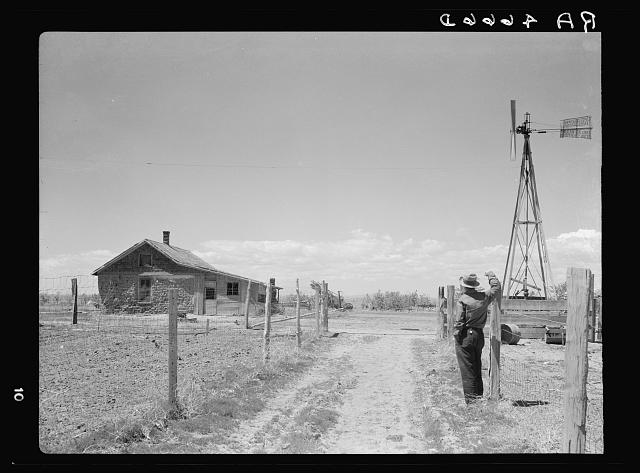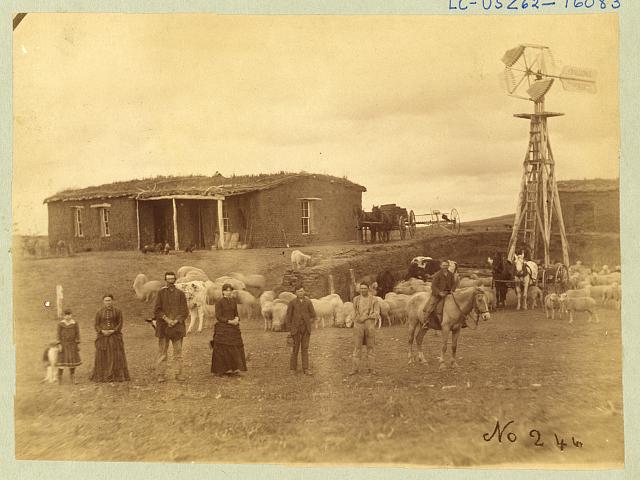Blog Archive
If You Can Make It Here: Becoming American through the Homestead Act

A photograph of Daniel Freeman's homestead, the first homestead secured through the Homestead Act. Photo courtesy of the Library of Congress.
It began as just your average New Year’s Eve party in Gage County, Nebraska Territory. With the Civil War raging on elsewhere, the folks in Gage County were trying to ring in 1863 in relative peace; However Daniel Freeman had another idea. Scheduled to leave Gage County as a Union scout, Freeman did not want to miss his opportunity to file his claim for land via the newly legal Homestead Act. At the New Year’s Eve Party, Freeman managed to convince officials in attendance from the Metropolitan Land Office to open the office a little earlier than normal so he could file his papers before shipping out.
Just after midnight Daniel Freeman became the first participant in the Homestead Act that apportioned public lands to private citizens.
Signed into law on May 20th 1862 the Homestead Act permitted the “preemptive” ownership of land. We should note, however, that the Act did neglect the fact that during this time period most of this land was far from uninhabited. All of the territories were already home to many Native American communities across the region. The Act had long been opposed by two very different groups. The first group consisted of Northern factory owners who feared the free land would entice their pool of labor away from crowded cities. The second group consisted of Southern politicians who feared that new states created in the western territories would be abolitionist and would vote to abolish slavery nationwide. Once the South attempted succession, Lincoln was quick to pass the Homestead Act.

A sod homestead in South Dakota. Built in 1900, the homestead had seen many hardships. The photo taken in 1936 shows the homestead in the midst of a new catastrophe: the dust bowl. Photo courtesy of the LOC.
The Act allowed pioneers the opportunity to own land merely by living on it for 5 continuous years. But wait. This is 1862 we are talking about – in Nebraska and in the Dakotas. Have you ever been to North Dakota? It is still hard to live there. Living on a plot of land for five continuous years took skill, luck and unbelievable depth of perseverance. It was hard and it was lonely to settle a plot of land which by definition was wild and unpopulated. Some of the land turned out to be difficult or even impossible to farm, which was basically the only means of sustenance for settlers – though some also survived by hunting and foraging. Plenty of homesteaders failed and fled back to territories where they could be around people, purchase goods, have electricity, and maybe even fall in love .

A photograph taken in 1886 of the William Moore and family, Sargent, Custer County, Nebraska. Photo courtesy of the LOC.
The Homestead Act was an important move west for those born on our shores and for those born abroad. The Act made the land available to anyone who was a United States citizen or who aimed to be. This legislative loophole allowed mostly European immigrants to come to the United States with the express purpose of settling land in the west. Scholars believe that legislators aimed to build the country as an agricultural power with farm labor lured from overseas. While we think of the Homestead Act as partly responsible for “making America” it is also responsible for making any number of Americans. One of the most famous pieces of literature documenting homesteaders, My Antonia by Willa Cather, takes European Immigrants as its protagonists. In 1973, historian Michael Lesy published Wisconsin Death Trip, a very different volume which unraveled some of the more romantic myths of pioneer life Lesy’s book examined the archives of the small town of Black River Falls in Wisconsin between 1890 and 1910. The archives told of a town barely tethered to sanity and felled by the many dangers of pioneer living. A cult classic, Wisconsin Death Trip was not the first tale of pioneer hardships but it helped begin a trend of historical perspective which helps us understand just how challenging it was to settle the western territories – then imagine doing so an ocean away from home and in a language not your own. It almost makes tenement dwelling look easy – almost.
–Posted by Julia Berick, Marketing and Communications Coordinator